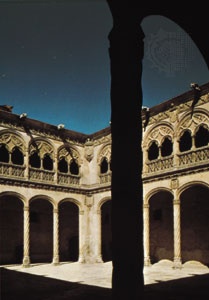Valladolid
Spain
 city, capital of Valladolid provincia (province), in the comunidad autónoma (autonomous community) of Castile-León,northwestern Spain. The city lies along the Pisuerga River at its confluence with the Esgueva, southwest of Burgos.
city, capital of Valladolid provincia (province), in the comunidad autónoma (autonomous community) of Castile-León,northwestern Spain. The city lies along the Pisuerga River at its confluence with the Esgueva, southwest of Burgos.The first recorded mention of Valladolid (Moorish Belad Ulid) appears to be in a letter of 1074 from Alfonso VI to Count Pedro Ansúrez granting him the lordship of the place. Under Ansúrez, Valladolid grew into a city of considerable importance. From the reign of Alfonso VII (12th century) to that of Philip II (and again from 1600 to 1606 under Philip III), it was the seat of the Castilian and then of the Spanish court. The Ansúrez lordship was ended in 1208 when Alfonso VIII incorporated Valladolid with the crown lands. The Catholic Monarchs, Isabella of Castile and Ferdinand of Aragon, were married there in 1469.
Valladolid suffered severely during the Peninsular War (1808–14), when many of its ancient buildings were destroyed by the French. Surviving architectural monuments are the collegiate church of Santa Cruz (late 15th century); the university, which has a Baroque facade (1715) by Narciso and Diego Tomé; the house of the counts of Rivadavia (now the Diputación Provincial), in which Philip II was born in 1527; and the Capitanía General palace, a former royal palace with a notable patio. The unfinished cathedral, incorporating parts of a 13th-century structure, was begun in 1585 by Juan de Herrera and was consecrated in 1688.
Other landmarks include the collegiate church of San Gregorio, of the 15th century, with a magnificent late Gothic facade, now housing a famous museum of wood sculpture and carving; and a monument to Christopher Columbus (erected 1905), who died in Valladolid on May 20, 1506. Valladolid's university (founded 1346) is one of the oldest in Spain. The city has many other educational institutions and is the seat of an archbishop.
Industry (food processing, engineering, textile and automotive manufacturing), commerce, and services are the most important sources of employment. There also is some work in forestry and agriculture in the irrigated lands surrounding the city. Pop. (2006 est.) 316,004.
province, Spain
provincia (province) in the comunidad autónoma (autonomous community) of Castile-León, northwestern Spain. It is bordered by the provinces of León and Palencia to the north, Burgos and Segovia to the east, Segovia, Ávila, and Salamanca to the south, and Zamora to the west. It is a great plain lying in the basin of the Duero River (Douro River), which crosses it from east to west. Northern Valladolid is part of the so-called Tierra de Campos, known as the “granary of Spain.” The most important crops there are barley, oats, and beets; sugar and chicory are grown, and alfalfa (lucerne) and corn (maize) are produced for fodder. The use of irrigation and agricultural mechanization is increasing in the province. Flour milling and winemaking are important, and there are other industries connected with food, as well as metalworking, textile weaving, chemical and automotive manufacture, construction, and tanning, all mainly in the provincial capital, Valladolid city. Besides Valladolid city, the main population centres are Medina del Campo, Iscar, Medina de Ríoseco, Peñafiel, and Tordesillas. Area 3,131 square miles (8,110 square km). Pop. (2007 est.) 521,661.
- Duncan Forbes
- Duncan Grant
- Duncan Hunter
- Duncan I
- Duncan II
- Duncan, Isadora
- Duncan, Otis Dudley
- Duncan Phyfe
- Duncan, Robert
- Duncan, Ronald
- Duncan Sandys
- Duncan Smith, Iain
- Duncan, Tim
- Texas Southern University
- Texas Tech University
- Texas, University of
- Texas v. Johnson
- Texas v. White
- Texas Woman's University
- Tex Avery
- Texcoco
- Texcoco, Lake
- Tex Rickard
- textile
- text messaging